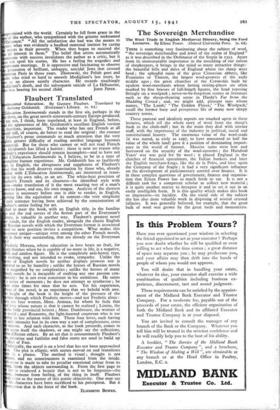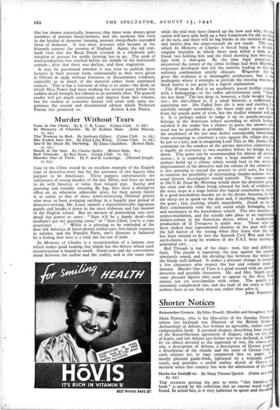The Sovereign Merchandise
THERE is something very fascinating about the subject of wool, " the sovereign merchandise and jewel of the realm of England " as it was described in the Ordinance of the Staple in 1353. Apart from its immeasurable importance in the moulding of our nation of shopkeepers, it brings to the mind so many attractive things : the beautiful hills and dales of England where the sheep were bred ; the splendid ruins of the great Cistercian abbeys, like Fountains or Tintern, the largest wool-growers of the early middle ages ; the great churches of the Cotswolds built by opulent wool-merchants whose lasting resting-places are often marked by fine brasses of full-length figures, the head reposing fittingly on a woolpack ; never-to-be-forgotten scenes in literature such as the sheep-shearing scene in Hardy's Far from the Madding Crowd ; and, we might add, pleasant inns whose names, ' The Lamb,' The Golden Fleece,' "The Woolpack,' recall the former busy and prosperous life of many now sleepy country towns.
These pastoral and idealistic aspects are touched upon in these lectures, which tell the whole story of wool from the sheep's back to the cloth-mill ; but in the main they deal with sterner stuff, with the importance of the industry in political, social and constitutional history. The enormous value of the wool-trade (it was stated, as early as 1297, to have amounted to half the value of the whole land) gave it a position of dominating import- ance in the world of finance. Massive sums were lent and borrowed on the security of the wool-customs • the Hundred Years' war was paid for by wool - it placed England in the clutches of financial speculators, the Italian bankers and later the English merchant-kings, like the de la Poles, and later again the Company of the Staple ; it had a very significant influence on the development of parliamentary control over finance. It is in these complex questions of government, finance and organisa- tion that Eileen Power has so much fresh to say. It is not a difficult task for a competent scholar to collect new material ; it is quite another matter to interpret it and to set it out in an easily intelligible form. It is this quality which makes this book so impressive—its lucidity. On the social side of the subject she has also done valuable work in disposing of several crusted fallacies. It was generally believed, for example, that the great bulk of wool was grown by the great lords and monasteries. She has shown statistically, however, that there were always great numbers of peasant sheep-farmers, and she surmises that even in the heyday of demesne farming, peasant sheep-flocks exceeded those of demesne. It was these peasants who became in the fifteenth century the yeomen of England. Again, the old text- book view that the Black Death resulted in a wholesale sub- stitution of pasture for arable farming has to go. The peak of wool-production was reached before the middle of the fourteenth century ; after that there was decline, and then stagnation.
It may be questioned whether it was wise to publish these lectures in their present form, substantially as they were given at Oxford in 1939, without footnotes or documentary evidence, especially as so much of the material comes from unprinted sources. This is but a foretaste of what is to come—the book on which Miss Power had been working for several years before her sudden death brought her labours to an untimely close. The general reader will get much enjoyment and interest from this volume, but the student of economic history will await with some im- patience the second and documented edition which Professor



























 Previous page
Previous page